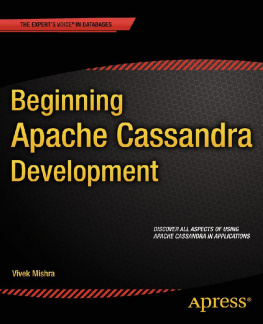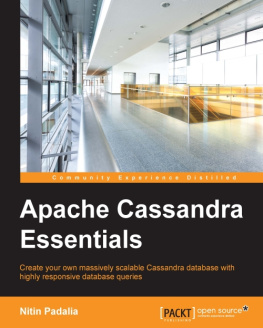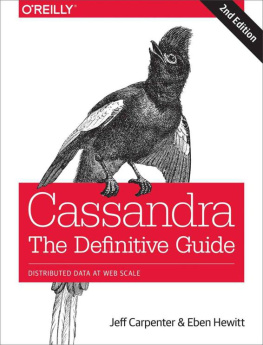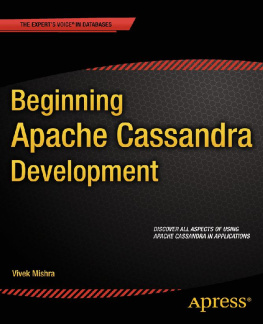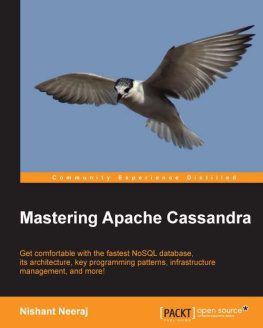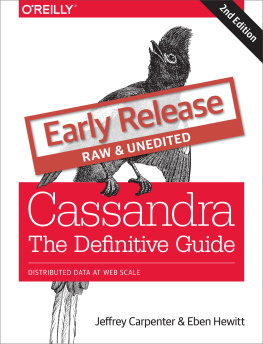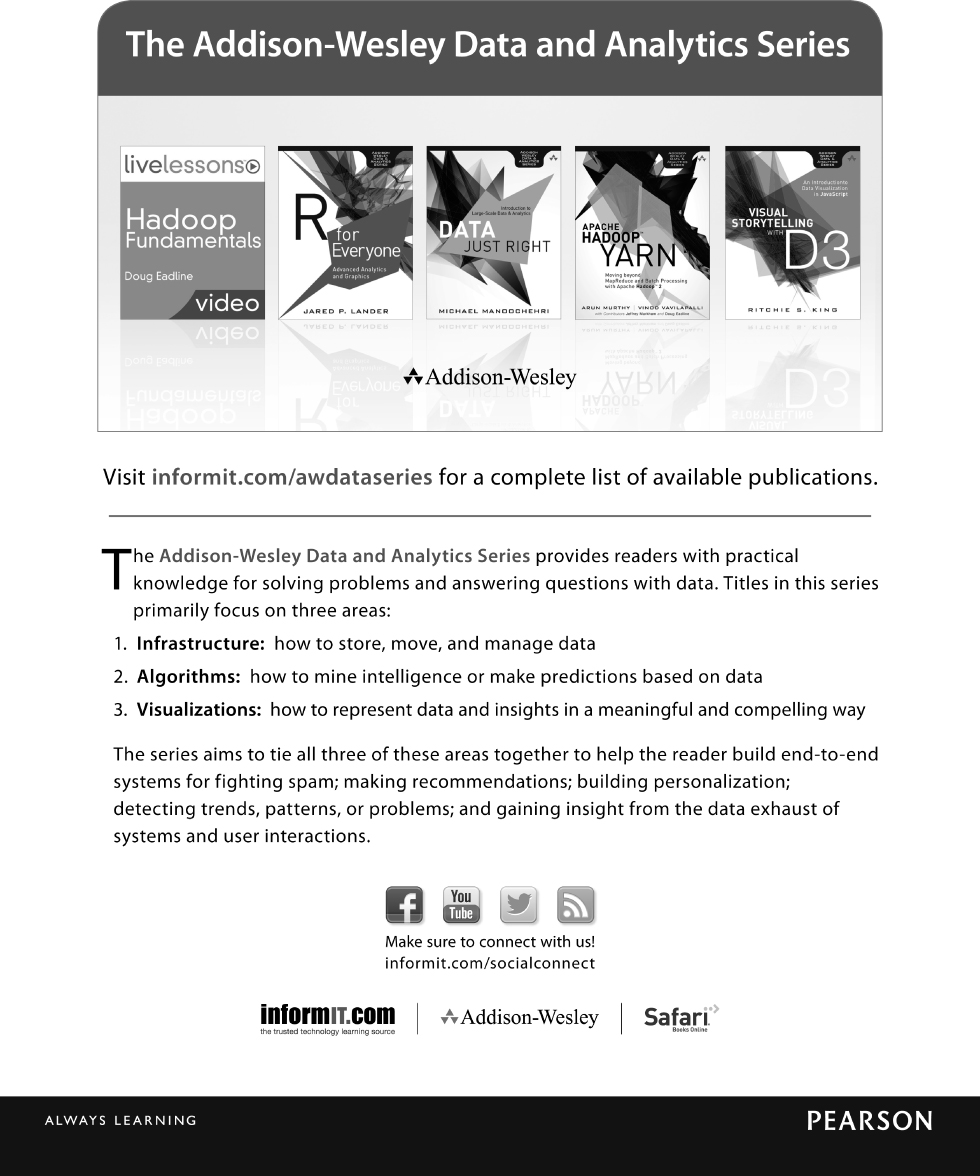About This eBook
ePUB is an open, industry-standard format for eBooks. However, support of ePUB and its many features varies across reading devices and applications. Use your device or app settings to customize the presentation to your liking. Settings that you can customize often include font, font size, single or double column, landscape or portrait mode, and figures that you can click or tap to enlarge. For additional information about the settings and features on your reading device or app, visit the device manufacturers Web site.
Many titles include programming code or configuration examples. To optimize the presentation of these elements, view the eBook in single-column, landscape mode and adjust the font size to the smallest setting. In addition to presenting code and configurations in the reflowable text format, we have included images of the code that mimic the presentation found in the print book; therefore, where the reflowable format may compromise the presentation of the code listing, you will see a Click here to view code image link. Click the link to view the print-fidelity code image. To return to the previous page viewed, click the Back button on your device or app.
Practical Cassandra
A Developers Approach
Russell Bradberry
Eric Lubow
Upper Saddle River, NJ Boston Indianapolis San Francisco
New York Toronto Montreal London Munich Paris Madrid
Capetown Sydney Tokyo Singapore Mexico City
Many of the designations used by manufacturers and sellers to distinguish their products are claimed as trademarks. Where those designations appear in this book, and the publisher was aware of a trademark claim, the designations have been printed with initial capital letters or in all capitals.
The authors and publisher have taken care in the preparation of this book, but make no expressed or implied warranty of any kind and assume no responsibility for errors or omissions. No liability is assumed for incidental or consequential damages in connection with or arising out of the use of the information or programs contained herein.
For information about buying this title in bulk quantities, or for special sales opportunities (which may include electronic versions; custom cover designs; and content particular to your business, training goals, marketing focus, or branding interests), please contact our corporate sales department at or (800) 382-3419.
For government sales inquiries, please contact .
For questions about sales outside the U.S., please contact .
Visit us on the Web: informit.com/aw
Cataloging-in-Publication Data is on file with the Library of Congress.
Copyright 2014 Pearson Education, Inc.
All rights reserved. Printed in the United States of America. This publication is protected by copyright, and permission must be obtained from the publisher prior to any prohibited reproduction, storage in a retrieval system, or transmission in any form or by any means, electronic, mechanical, photocopying, recording, or likewise. To obtain permission to use material from this work, please submit a written request to Pearson Education, Inc., Permissions Department, One Lake Street, Upper Saddle River, New Jersey 07458, or you may fax your request to (201) 236-3290.
ISBN-13: 978-0-321-93394-2
ISBN-10: 0-321-93394-X
Text printed in the United States on recycled paper at RR Donnelley in Crawfordsville, Indiana.
First printing, December 2013
This book is for the community. We have been a part of the
Cassandra community for a few years now, and they have
been fantastic every step of the way. This book is our way of
giving back to the people who have helped us and have
allowed us to help pave the way for the future of
Cassandra.
Foreword by Jonathon Ellis
I was excited to learn that Practical Cassandra would be released right at my five-year anniversary of working on Cassandra. During that time, Cassandra has achieved its goal of offering the worlds most reliable and performant scalable database. Along the way, Cassandra has changed significantly, and a modern book is, at this point, overdue. Eric and Russell were early adopters of Cassandra at SimpleReach; in Practical Cassandra, you benefit from their experience in the trenches administering Cassandra, developing against it, and building one of the first CQL drivers.
If you are deploying Cassandra soon, or you inherited a Cassandra cluster to tend, spend some time with the deployment, performance tuning, and maintenance chapters. Some complexity is inherent in a distributed system, particularly one designed to push performance limits and scale without compromise; forewarned is, as they say, forearmed. If you are new to Cassandra, I highly recommend the chapters on data modeling and CQL. The Cassandra Query Language represents a major shift in developing against Cassandra and dramatically lowers the learning curve from what you may expect or fear.
Heres to the next five years of progress!
Jonathon Ellis, Apache Cassandra Chair
Foreword by Paul Dix
Cassandra is quickly becoming one of the backbone components for anyone working with large datasets and real-time analytics. Its ability to scale horizontally to handle hundreds of thousands (or millions) of writes per second makes it a great choice for high-volume systems that must also be highly available. Thats why Im very pleased that this book is the first in the series to cover a key infrastructural component for the Addison-Wesley Data & Analytics Series: the data storage layer.
In 2011, I was making my second foray into working with Cassandra to create a high-volume, scalable time series data store. At the time, Cassandra 0.8 had been released, and the path to 1.0 was fairly clear, but the available literature was lagging sorely behind. This book is exactly what I could have used at the time. It provides a great introduction to setting up and modeling your data in Cassandra. It has coverage of the most recent features, including CQL, sets, maps, and lists. However, it doesnt stop with the introductory stuff. Theres great material on how to run a cluster in production, how to tune performance, and on general operational concerns.
I cant think of more qualified users of Cassandra to bring this material to you. Eric and Russell are Datastax Cassandra MVPs and have been working extensively with Cassandra and running it in production for years. Thankfully, theyve done a great job of distilling their experience into this book so you wont have to search for insight into how to develop against and run the most current release of Cassandra.
Paul Dix, Series Editor
Preface
Apache Cassandra is a massively scalable, open-source, NoSQL database. Cassandra is best suited to applications that need to store large amounts of structured, semistructured, and unstructured data. Cassandra offers asynchronous masterless replication to nodes in many data centers. This gives it the capability to have no single point of failure while still offering low latency operations.
When we first embarked on the journey of writing a book, we had one goal in mind: We wanted to keep the book easily digestible by someone just getting started with Cassandra, but also make it a useful reference guide for day-to-day maintenance, tuning, and troubleshooting. We know the pain of scouring the Internet only to find outdated and contrived examples of how to get started with a new technology. We hope that



